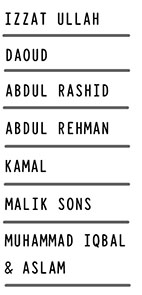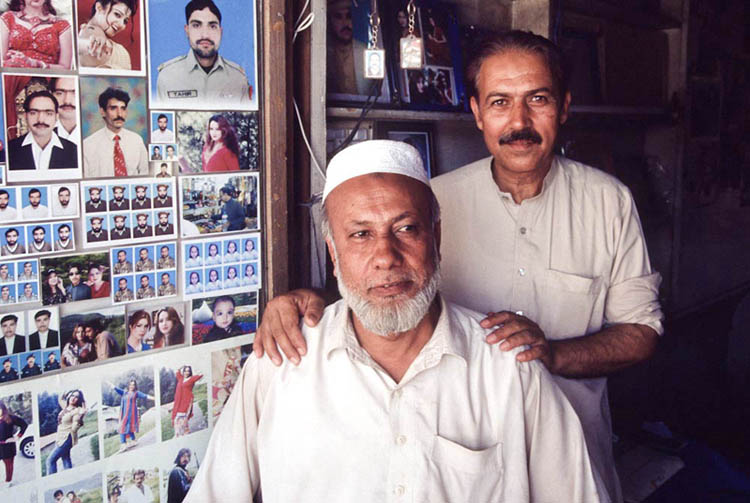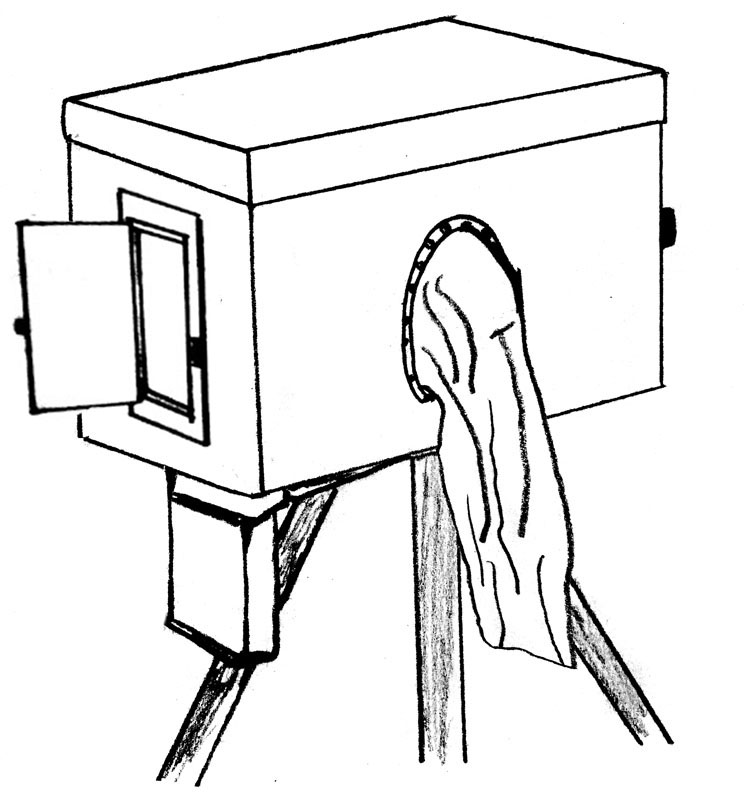|
| MUHAMMAD IQBAL & ASLAM | |||||||
Muhammad Iqal, 48, standing behind his friend Aslam in the photo above, has had the Kamran Studio on Cinema Rd. Peshawar, his hometown, for over thirty years. He learnt photography on a medium format camera. When refugees from Afghanistan started arriving in Peshawar after 1979, a number of them, he recalls, asked if they could work on Cinema Rd. So he rented out the space in front of his shop to one of them. The Afghans - there were only ever about five at most - brought along their box cameras from Afghanistan, which Peshawaris knew as 'minute' cameras. Muhammad learnt how to use the camera from the Afghans and would practise with it when they went on their lunch break. But about twelve to fifteen years ago the camera was finished on the street, he says. Either the Afghans returned home, he speculates, or they moved to other areas in Peshawar like Board, close to a large refugee camp, where they continued to work. A gallery of hand-coloured portraits including montages by Muhammad Iqbal can be seen here. Aslam, an elderly gentleman, appears in Iqbal's studio. They are close friends. Aslam, 70, was taught how to use the box camera by his father, Fasel Rahman Mogul, when he was fifteen. "My father was one of the first photographers in Peshawar," he says with pride, "and part of the Mogul family." Fasel Rahman moved to Peshawar from India before partition. He adored movies. Because of his interest in the image, when he was around thirty-five he decided to become a photographer. A Sikh photographer working with a box camera on Cinema Road became his teacher. That was before 1935, he says, and there were only three Sikh box camera photographers and his father working on the street as 'standing' photographers. Afterwards, when Aslam had learnt how to use the camera, he joined his father on the street. Subsequently they opened a photo shop at Kabuli gate. In the beginning, Aslam says, the box camera was only used for passport photos. One photo cost two paisa. Only when films from India became really popular and people asked for photos with the movie stars did they start to make collages with the box camera (more on box camera collages here). Pondering the origins of the camera, Aslam says the box camera probably came from India: it was different to the one the Afghans brought from Afghanistan in the late 1970s. It was a little smaller. The developer was in a tank - a drop down tank - the focus plate wasn’t attached to a pole and its position was changed by hand, while the sleeve was on the side of the camera.
Aslam believes that at some stage the Afghans copied the 'Indian' camera, then changed it, and this was the camera they brought back to Peshawar at the end of the 1970s. In turn, some Pakistanis then copied the Afghan version. It was only when the Afghans arrived during the Russian time in Afghanistan that the box camera became really popular, he says, adding that the photographers who came as refugees were good, and successful, because a "minute picture" was fast and cheap. Aslam closed his studio twelve years ago, because, he says, he is getting old.
|
|||||||
|
|||||||






